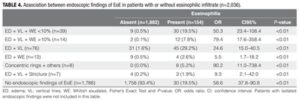HIGHLIGHTS
The EoE endoscopic reference score (EREFS) was developed and validated in adults and has been demonstrated to be an adequate tool for diagnosing and assessing treatment response in children.
• The presence of more than one endoscopic finding strongly suggests EoE.
• The EoE endoscopic reference score presents high specificity and negative predictive value for diagnosing EoE in children naïve to proton pump inhibitor (PPI) therapy.
• Endoscopic findings suggestive of EoE in patients naïve to treatment may be useful to characterize disease phenotype and individualize treatment according to the initial clinical presentation.
ABSTRACT – Background –
To assess the efficacy of applying the endoscopic reference score for EoE (EREFS) in children with symptoms of esophageal dysfunction naïve to proton pump inhibitor (PPI) therapy. Methods – An observational cross-sectional study was conducted by reviewing reports and photographs of upper gastrointestinal endoscopies (UGE) and esophageal biopsies of patients with symptoms of esophageal dysfunction. Patients who were treated with PPI or had other conditions that may cause esophageal eosinophilia were excluded. Results – Of the 2,036 patients evaluated, endoscopic findings of EoE were identified in 248 (12.2%) and more than one abnormality was observed in 167 (8.2%). Among all patients, 154 (7.6%) presented esophageal eosinophilia (≥15 eosinophils per high power field) (P<0.01). In this group, 30 patients (19.5%) had normal endoscopy. In patients with EoE, edema (74% vs 6.5%, P<0.01) and furrows (66.2% vs 2.4%, P<0.01) were more prevalent than in the control group. Association of edema and furrows was more frequent in patients with EoE than in the control group (29.2% vs 1.6%, P<0.01, OR=24.7, CI=15.0–40.5). The presence of more than one endoscopic finding had sensitivity of 80.5%, specificity of 93.4%, positive predictive value (PPV) of 50%, negative predictive value (NPV) of 98.3%, and accuracy of 92.4%. Conclusion – In conclusion, this study showed that endoscopic features suggestive of EoE had high specificity and NPV for diagnosing EoE in children naïve to PPI therapy. These findings highlight the importance of the EREFS in contributing to early identification of inflammatory and fibrostenosing characteristics of EoE, making it possible to identify and to avoid progression of the disease.
AUTORES
Luciana M RIBEIRO, Mário C VIEIRA, Sabine K TRUPPEL and Nelson A ROSÁRIO FILHO


